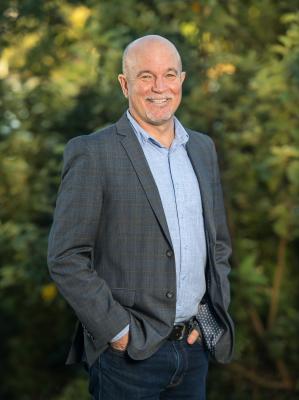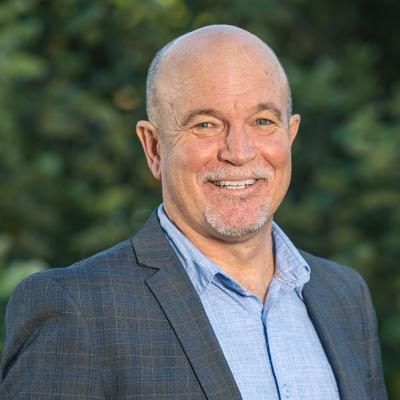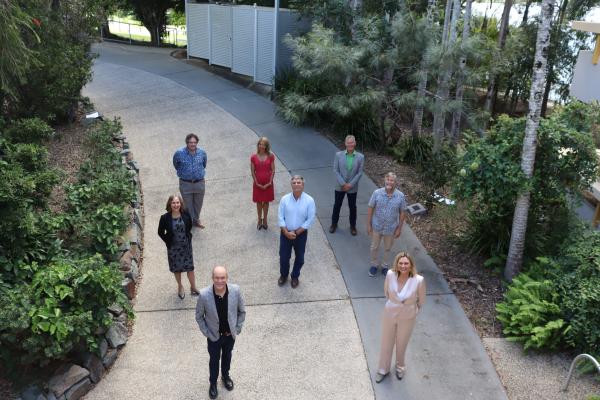Noosa Council CEO Brett de Chastel is widely regarded as one of the best operators to ever hold that office, the power behind the throne who remains cool, calm and collected through the tumult and the shouting. In a rare break from his policy of keeping a low profile, he sat in the Hotseat for Phil Jarratt.
How do you get a name like de Chastel?
In a nutshell, my great grandfather was a French convict transported to the penal colony in New Caledonia. His surname was Charmiere and he escaped from prison in Noumea and stole a small boat with other convicts and set sail for Australia. Several convicts died on the journey but he survived and they landed in Queensland. He changed his name to de Chastel in reference to the region in France he was from.
I was born in Innisfail. My dad worked for a bank and we got shifted around every couple of years. I ended up going to seven different schools and living all over Queensland and then going to university in Brisbane, a 17-year-old kid who didn’t really know what he wanted to do. Oddly enough journalism looked pretty interesting, so I enrolled in a bachelor of arts majoring in journalism, but did a law degree at the same time. At the end of my third year I had my journalism major, but every journalist I ran into seemed like an alcoholic or a cynic! (Laughs)
Usually both!
So I finished my law degree, then went up to Mareeba where my parents were and worked in a one-man firm, which was a great grounding. But I was young and single, so I was drawn back to Brisbane. I was a serious soccer player and one weekend I broke my leg and was on crutches. I saw an ad for an in-house lawyer for Ipswich City Council to do their town planning work. This was the early days of political correctness in job ads, so they said they were “an equal opportunity employer looking for a solicitor regardless of physical or mental impairment”. I turned up on crutches and got the job. My plan was to work in council for two years, then go back to the private sector and make my fortune, but I found the work really interesting, and I met my wife-to-be at that time, so I hung around for quite a bit longer, going through the first of my council amalgamations (Ipswich City and Moreton Shire in 1995) and then deciding that it would be even more interesting to be making the decisions rather than giving advice, so I applied for the job of deputy CEO and got it. At the 2000 elections Paul Pisasali was elected mayor and within 12 months I felt I needed to leave.
Is my memory correct that when he was elected Pisasali was a bit of a golden boy?
Very much so, and the CEO was a very good one, who was able to keep Pisasale under control, to keep boundaries around him. Then he left, and there were no boundaries.
What was it specifically that drove you to leave?
I’d say it was my moral compass, but also my kids at that time were two and four, and my wife Sue and I were talking about where we wanted to bring them up. We were thinking of a nice, safe coastal environment, and the Noosa came up a lot in our conversations. I opened up the paper one morning and Noosa Shire Council was advertising for a director of corporate services. I applied for the job, got it and came here in August 2001. I took a pay cut to come and it was the best decision I ever made. I worked with CEO Bruce Davidson for the next seven years, with Bob Abbot as mayor and some really interesting councillors, great staff, and I just fell in love with Noosa, and, to be honest, with Noosa Council. It was a great place to work until the dark clouds of amalgamation began to come over the horizon.
Having seen a good amalgamation from the inside at Ipswich, could you see from the get-go that this was a bad one?
Absolutely. Amalgamations are successful where there is a set of common values or a shared sense of place. The Noosa and Sunshine Coast amalgamation never had that. It was always going to be a struggle, and there were four or five other places in Queensland where this was also true.
In Noosa/Sunshine Coast what was driving that lack of common purpose? Cultural differences?
I’d say more community differences, the sense of what makes a community. At the risk of over-simplifying it, it was a bigger-is-better philosophy versus a niche philosophy. But it was also about the tourism sector, one being about volume and one being about value. Overall a sense of localism versus regionalism, which was a fundamental difference.
Bruce Davidson and I decided that one of us had to go off-line for six months to build the anti-amalgamation case, so I took that on. I stepped back from normal duties and turned a little meeting room here into a war room and ran the campaign, from petitions to lobbying politicians to the big street march in Brisbane. We fought hard and we lost, and that was pretty disheartening.
Some (members of staff) decided to leave, others including myself stayed on with Sunshine Coast Council, but my heart wasn’t in it and after about five months I decided to leave and set up a consulting business, going around Queensland helping fix broken councils. I did that for the next six years, worked with about 25 councils across the state, including some of the most personally satisfying work of my career with the Indigenous councils of Cape York. It was a tremendously rewarding experience and I met some amazing people.
Were there any takeaways from your Indigenous experience that you were able to bring back into the other council world?
Listening to community is one. When they talk about community engagement, they’re serious about it. They know if they get it wrong, they’ll have to live with a lot of very unhappy aunties and uncles, so there’s a lot of talk before any decision is made, and in my observation, that leads to better decisions.
In 2013 the de-amalgamation campaign really started to gather momentum. Did you play a part?
I did, but behind the scenes. I was asked to put together the business case to present to the state government, that we’d be economically successful if we de-amalgamated. The state had to be comfortable that along with the political will to de-amalgamate went the knowledge that it would work.
How did you become CEO?
At the end of 2013 Noosa Council advertised nationally for a CEO and I applied, along with 45 others, and was lucky enough to get the job after an independent assessment. My local knowledge certainly helped because I could hit the ground running, but there were other very good, very worthy candidates.
What exactly is the role of a council CEO? It’s not quite the same as the CEO of the law firm down the road, is it?
No, it’s quite different. Probably the best analogy is this: it’s like being a conductor of an orchestra. You’ve got all these things going on at once, and sometimes you have to bring the drums up a bit and the violins down a bit, and the whole time you’ve got the audience watching. Another way of looking at is that local government is like a very small multinational, in that we’re running a waste business and a library, a respite centre and a landscaping business, an aquatic centre and a cemetery. The range is incredible. The only reason we run all of these things is that they’re not viable from a private sector perspective – none are designed to make money. Then there’s the fact that our 55,000 customers get to elect the board of directors every four years, the board meetings are open to the media and the customers, and the board gets a free performance appraisal every time the paper comes out. (Laughs) It’s an unusual business model, and we’ve got a billion dollars’ worth of assets that we look after on behalf of the community.
Do you have your finger on the pulse of all those micro-businesses you mentioned or do you delegate?
I’ve got a great management team and that’s what they do, but one of my quirks is that every three or four months I go and work in a different part of the organisation for a day, so I might be laying out bitumen or handing out library books.
Really? Laying bitumen? What was the last job you tried?
Concreting a footpath. The hardest one I’ve done was with a tree crew, cutting down trees in the heat of summer. It’s important to know what’s going on out there, but my day to day job is to find the glue that binds us together.
You’ve outlined how council works, but outside the Pelican Street fortress it’s all just “the council” which gets blamed for just about everything. Is that depressing?
Not depressing, but when you do get positive feedback it’s really worthwhile. If you let it get to you, you lose sight of what you’re trying to achieve, so you just have to roll with the punches.
Is it a general rule that the CEO remains aloof from politics?
Yes, and during an election campaign I don’t go to any of the functions for any of the candidates. My job is to come in the day after the election is declared and see who the community has put forward and to make it work. And that’s what we’re doing now. It was quite an adversarial election in March, no getting around that, and we had new people coming in, but part of my job is to get that group together and to work with the mayor to get everyone to work as a team.
One new councillor recently told me that it doesn’t matter what you said in a campaign, once you walk through the door of council chambers, you’re starting a whole new learning curve.
Absolutely. Most new councillors are surprised by the range and complexity of council business. With turnover over $100 million a year, there’s a lot to learn. Over the first few months I’ve spent a lot of time explaining how it all works, an intense process but it’s ending now.
You had COVID-19 land at about the same time as the new council. Has that been a challenge?
Yes, it’s been difficult for everyone. It’s been full-on for the new councillors, the council staff and all of us as we’ve had to navigate through uncertainty, with no budgetary assumptions making any sense when you don’t know what’s going to happen. On the other hand, it’s been good for the new council group to face these challenges together.
I made an executive decision not to put the New Noosa Plan up to the new council too early, we needed them to get their feet under the table and see how local government works before looking at that. Whenever it was brought on, they would have to decide to vote for it or against it, but it was important for them to understand the issues first. That’s the trick with successful councils. You’re not going to agree on difficult issues all the time, but once you’ve voted on them, you move forward.
How’s Noosa doing in these strange times?
Pretty good. We’ve got a resilient community, as we saw in the fires last year. The hard thing is we don’t know what the future holds. We’re in a scenario future. There is no one future, it might be one of half a dozen scenarios that might play out, and we have to plan for each of them, and be adaptable and flexible enough to move ahead.






![[READER COMPETITION] – Win tickets to the Queensland Ballet at The J Theatre](https://noosatoday.com.au/wp-content/uploads/2025/07/Queensland-Ballet-100x70.png)



